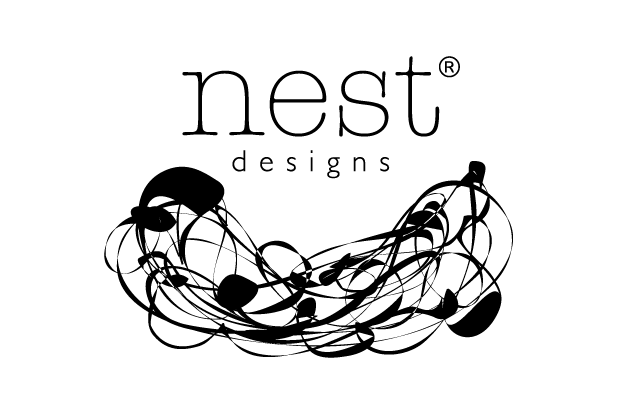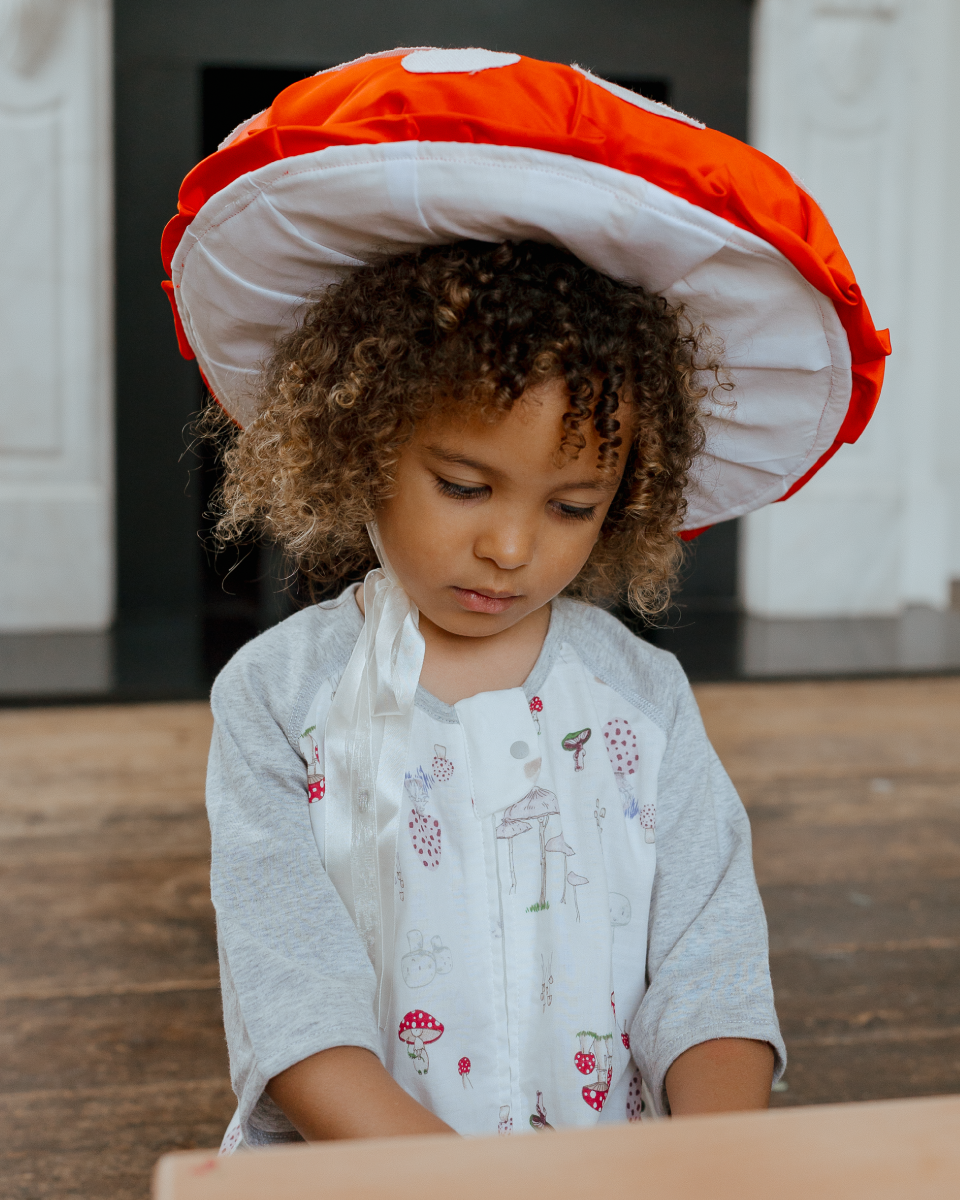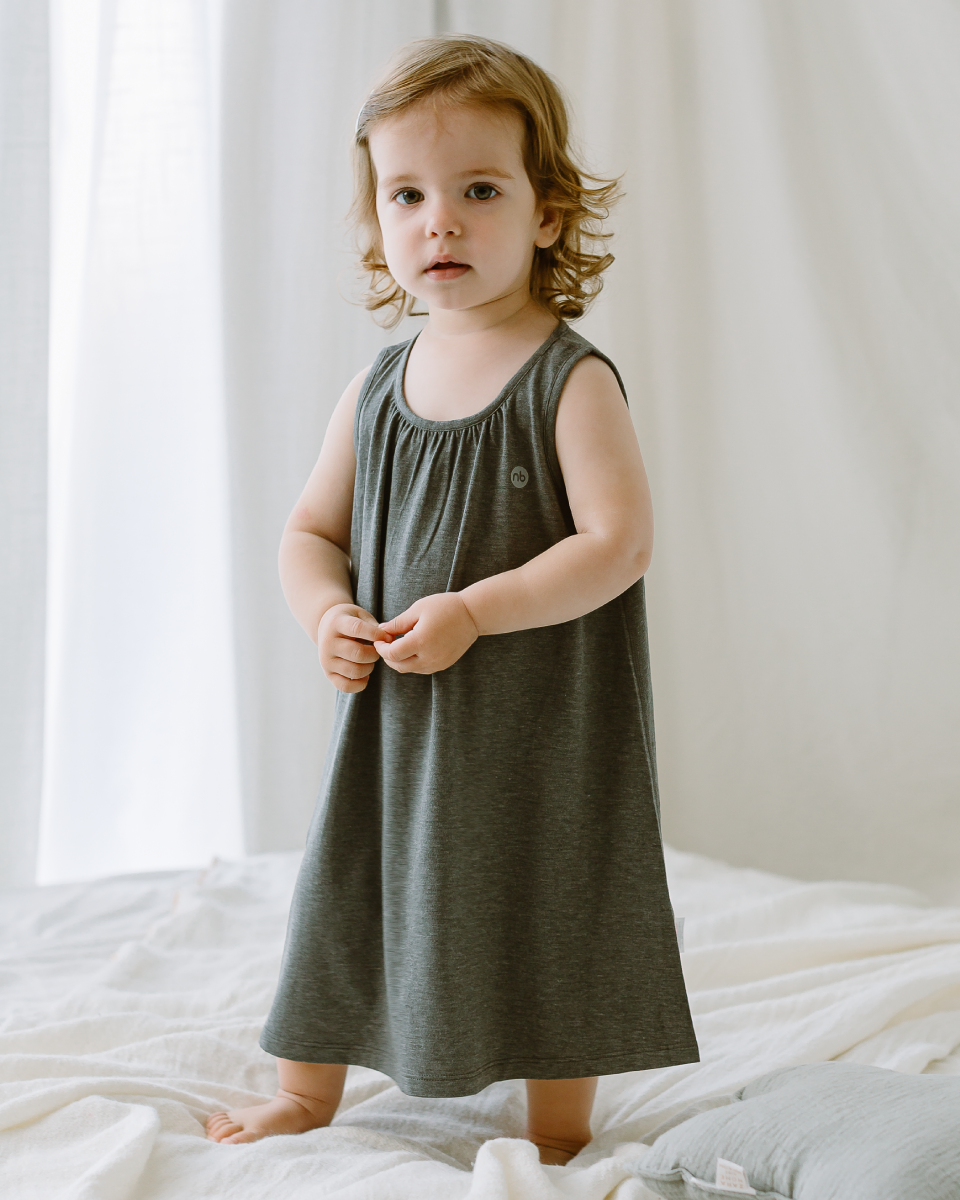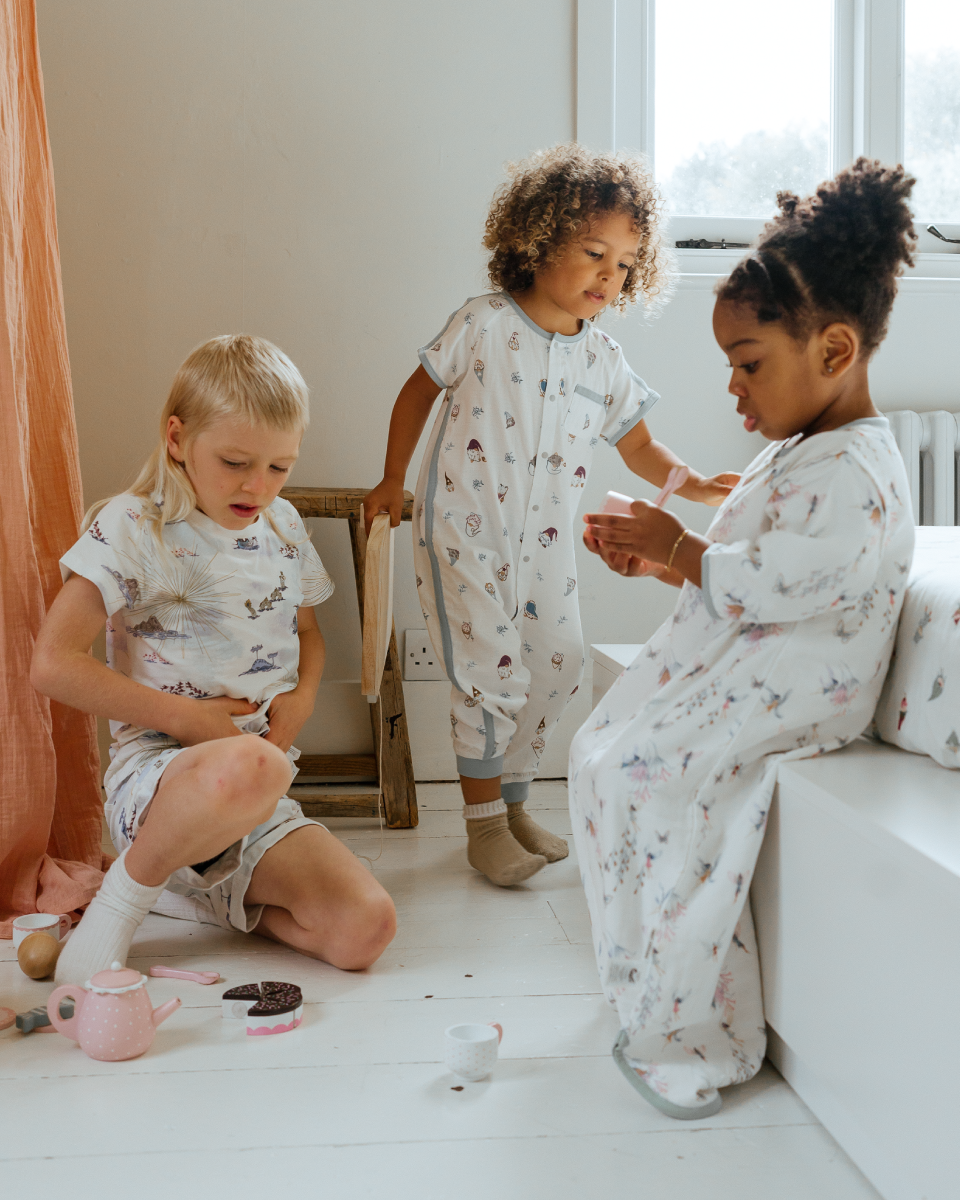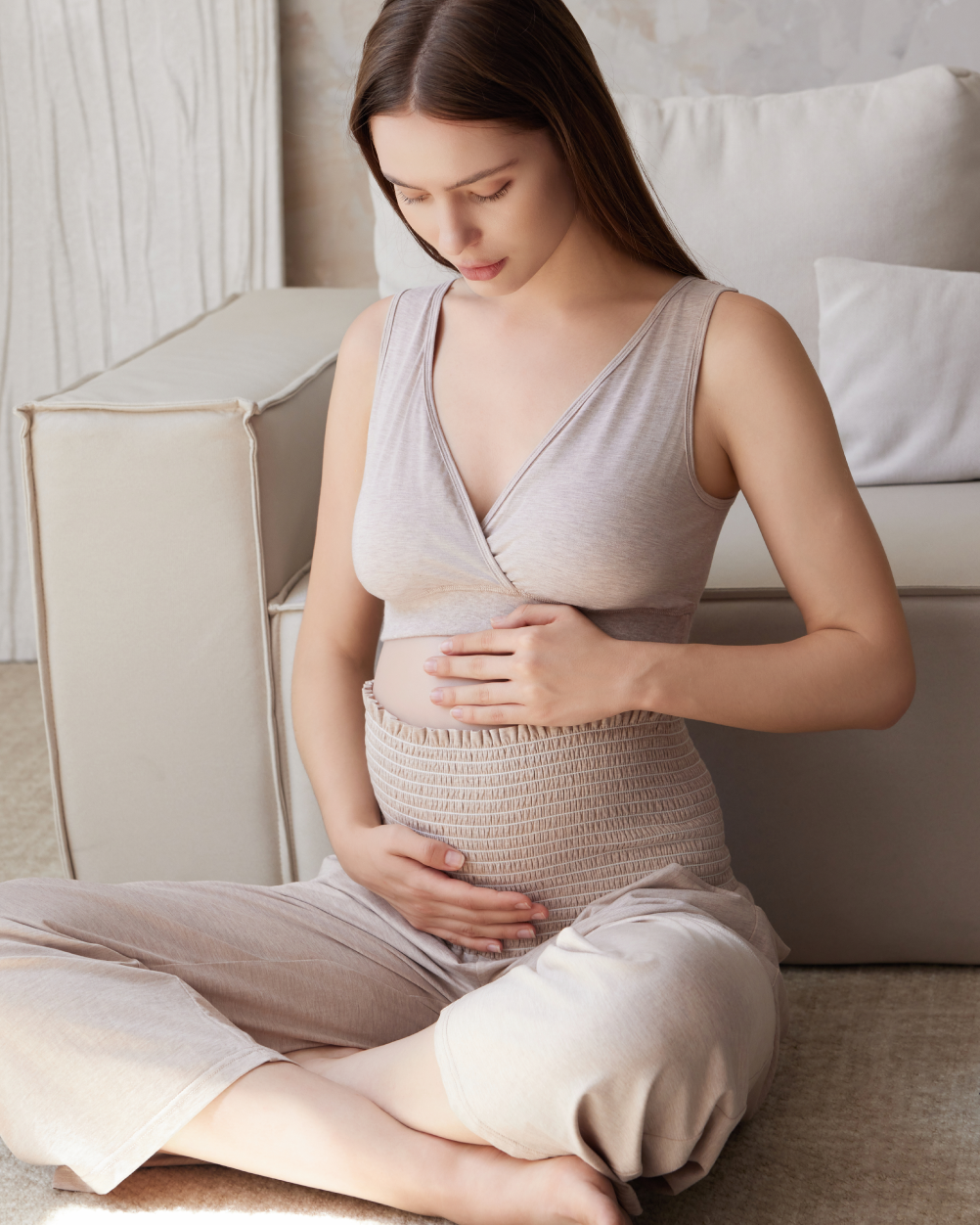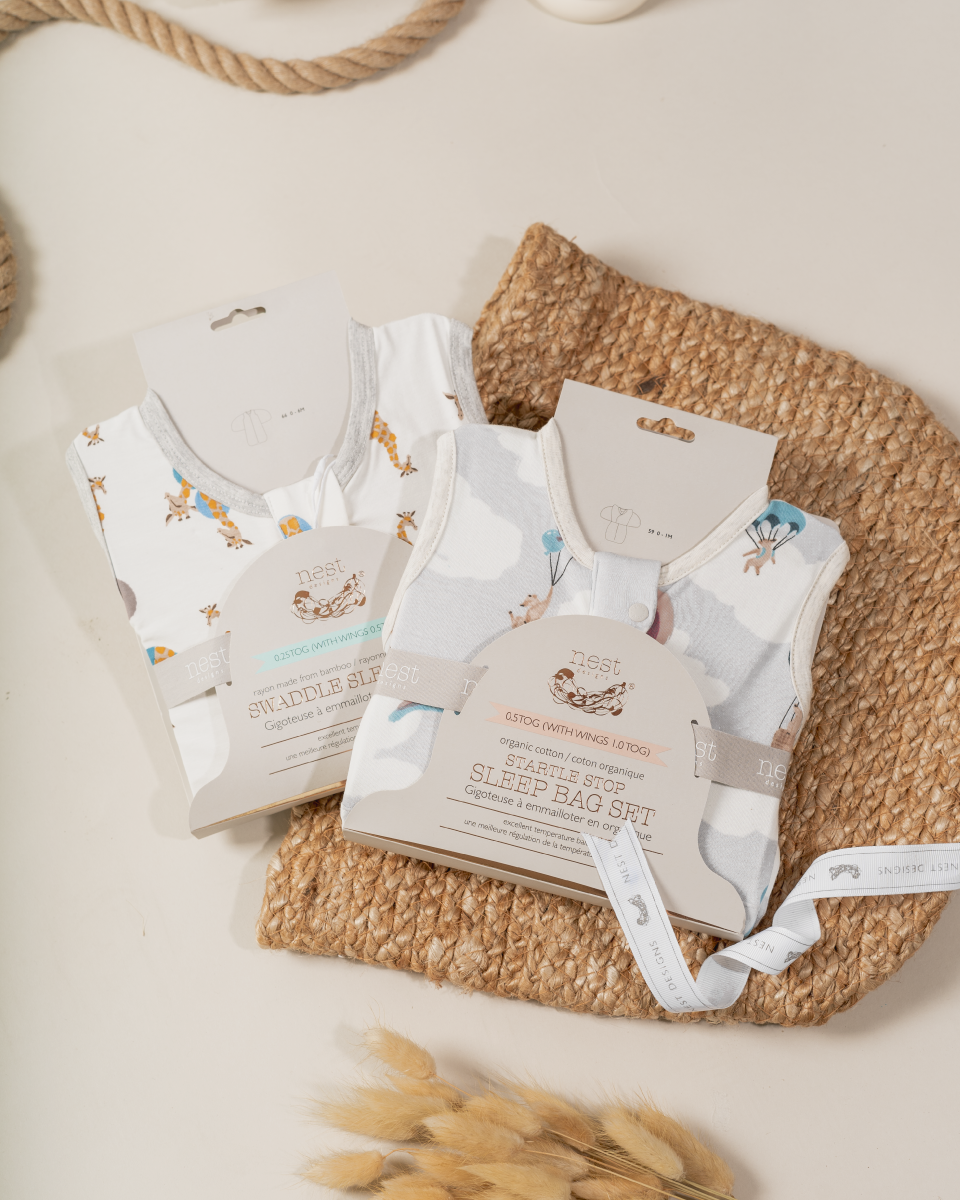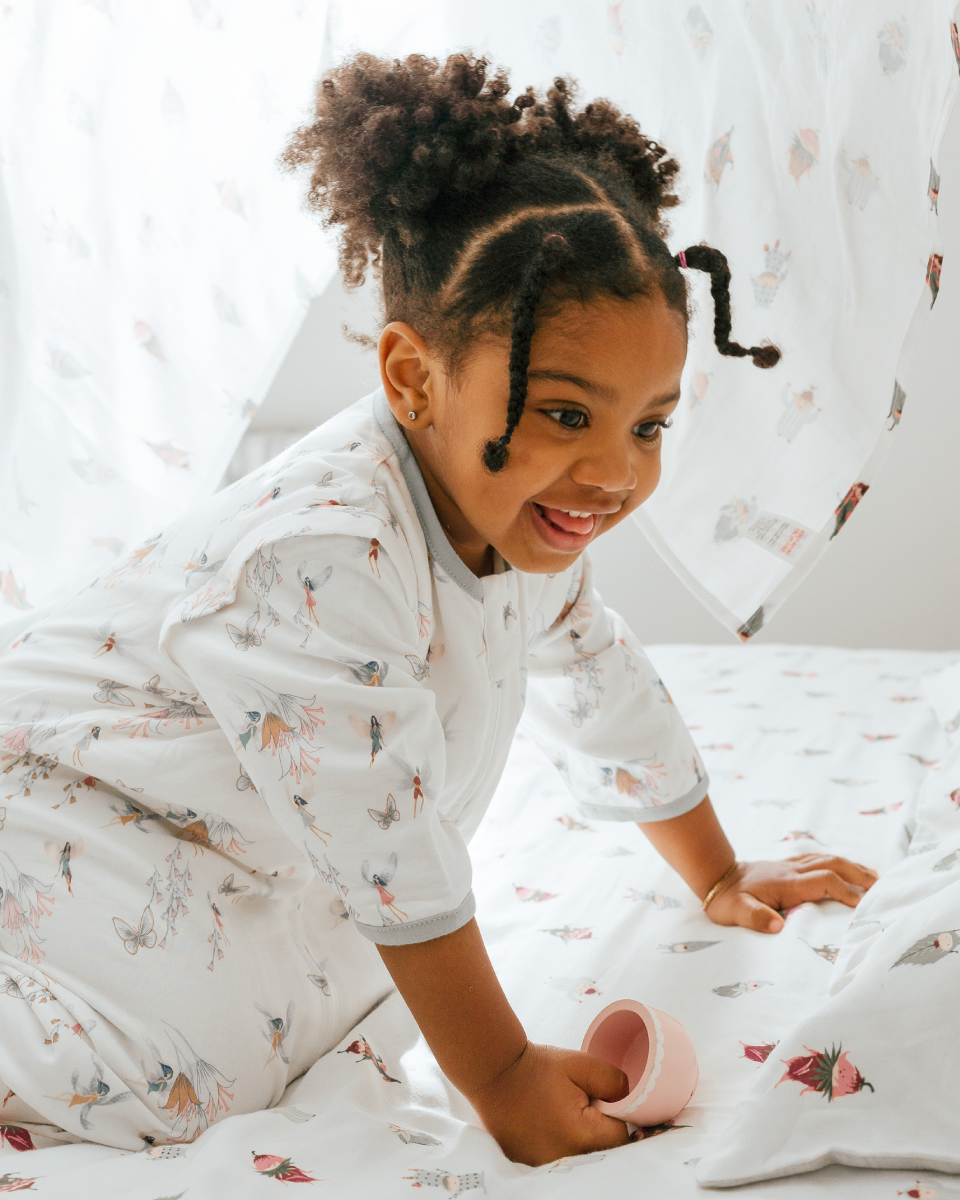
A baby sleep sack, or sleep sack, is a wearable blanket designed for babies to keep them safe, cuddly, and cute while they snooze. It is a single-piece blanket-like bodysuit that is a safer alternative to a loose blanket. It features an opening for the baby's head, holes or sleeves for the arms, and a sleeping bag bottom to keep them warm and cozy down to their toes.

What are Sleep Sacks used for?
A sleep sack is a wearable blanket that contributes to safer sleep for babies. The American Academy of Pediatrics and the Canadian Pediatrics Society do not recommend using blankets for newborns due to Sudden Infant Death Syndrome (SIDS) risk. As such, many parents opt for a baby sleep sack for bedtime warmth and security.
Sleep Sacks for Every Baby
Our sleep sacks at Nest Designs come in various styles, sizes, colours, and beautiful hand-drawn prints. We make our sleep sacks using premium, eco-friendly materials that are oh-so-soft and healthy for little ones. (Read more about our sustainable and gentle fabrics.)
 |
 |
 |
| Sleeveless sleep sacks | Long sleeve sleep sacks | Sleep sacks with removable sleeves |
What is the difference between a sleep sack and a swaddle?
The main difference between a sleep sack and a swaddle is whether or not the baby has freedom of movement for their arms and legs during naptime or bedtime. The best option depends on a baby's age and developmental stage.
A baby sleep sack is a wearable blanket for babies beyond the newborn stage. It's designed with a loose-fitting sleeping bag bottom and arm holes or sleeves, so it moves with even the most active sleepers. A sleep sack allows the little bub to freely move their arms and legs (or even roll over in their sleep) to find the most comfortable position during slumber.

A swaddle offers newborns and infants the snug security and warmth they felt in the womb. Swaddling is a method in which parents use a swaddle blanket to wrap their little bub up to resemble a baby burrito. The swaddling method comfortably bundles their little arms and legs, limiting the baby's movements and preventing them from waking up from their startle reflex.

How to transition baby from swaddle to sleep sack
Transitioning a baby from a swaddle to a sleep sack or sleep sack is essential to their development as they grow and become more mobile.
Here's a step-by-step guide outlining the steps in transitioning from a swaddle to a sleep sack:
- Choose the right time: Many experts recommend transitioning from a swaddle to a sleep sack when your baby starts showing signs of rolling over or if they are around two to four months old.
- Transition gradually: Avoid abrupt changes to sleep routines. Start by leaving one arm out of the swaddle while the other remains inside. Having one arm free helps them get used to the sensation of mobility.
- Pay attention to the little one's development: Swaddling becomes unsafe when a baby can roll onto their stomach (creating safety risk as they may not be able to roll back). At this point, stop swaddling altogether.
- Switch to an appropriate baby sleep sack: Choose a sleep sack that's sized appropriately and is seasonally appropriate.
- Create a bedtime routine: a consistent order of activities before bed helps signal to a baby that it's time to sleep.
- Be patient: Some babies need a little time to adjust from the security of a swaddle to the freedom of a sleep sack.
Are sleep sacks necessary?
Sleep sacks are extremely helpful in aiding a little one with their sleep. Though they are not necessary, they offer safety for babies and peace of mind for parents. Sleep sacks made from breathable and thermal regulating material, like bamboo or organic cotton, also reassure moms and dads that their little ones won't overheat or be too cold during slumber.
What should babies wear under sleep sacks?
What babies wear under a sleep sack depends on the season, the temperature of a baby's room, and the TOG rating of the sleep sack. (What is a TOG rating?)
As a general rule of thumb, babies should wear their pajamas or onesies underneath a sleep sack on cooler nights. During warmer seasons, little ones can wear their onesie or just a diaper underneath their sleep sacks.
| TOG | Room Temperature | Suggested Apparel Pairing |
| 0.23 | 26-29°C | Ultra light weight can be layered over diaper or underwear |
| 0.5 | 25-27°C | Light weight, can be worn over diaper or underwear or layered with short sleeve onesie |
| 0.6 | 24-26°C | Light weight, can be worn over diaper or underwear or layered with short sleeve onesie or light PJs |
| 1.0 | 20-24°C | Mid-light weight, can be worn over diaper or layered over long sleeve onesies or PJs |
| 2.0 | 18-22°C | Mid-heavy weight, can be layered over onesies or PJs |
| 2.5 | 16-20°C | Mid-heavy weight, can be layered over onesies or PJs |
| 3.5 | 13-16°C | Heavy weight, can be layered over PJs |

When should babies start wearing sleep sacks?
Babies generally use a baby sleep sack or sleep sack later in their development, usually around or after three months of age. It's up to a parent to decide the best time to transition to a sleep sack.
Every baby is unique, and their preferences may influence when they start wearing a sleep sack. While some babies don't like their little arms and legs restricted in the swaddle, some prefer its womb-like security.
When should babies stop using sleep sacks?
Babies should stop using sleep sacks once they become more active and move around more during the night. Signs that it's time to get out of a sleep sack include standing, jumping, or even trying to climb out of their crib. Their little legs and feet encased in a sleep sack make it a tripping hazard for babies and toddlers on the go. At this point, little ones can graduate to one of our baby sleep bags (sleep sacks with feet).

Are sleep bags safe for babies?
By around three to four months, babies want to gain more mobility and movement for their arms and legs. Sleep bags and sleep suits are much safer alternatives than a swaddle or loose blanket.
Sleeping bags are perfectly safe as long as your baby's arms are free so they can maneuver themselves into a more comfortable sleep position. Sleep bags provide the security little ones need during their sleep, all the while keeping their arms free to move.
Are sleep bags safe for babies who can roll over?
Sleep bags are meant for babies who can roll over—babies with this ability are safer in a sleep bag than in a swaddle. If they were to roll over while swaddled, they risk getting stuck in a position they can't get out of, putting them at risk for SIDS. In a sleep bag, their arms are free so they can push themselves to roll onto their backs again.

Do sleep sacks prevent SIDS?
While sleep sacks themselves don't prevent SIDS, they play a role in safer sleep. Sleep sacks replace traditional loose blankets, which can pose a suffocation risk if they cover a baby's face. Sleep sacks help keep babies warm while allowing them to maintain a clear airway, which is one of the critical factors in reducing SIDS risk.
How do you choose the right sleep sack?
When it's time to upgrade a little bub from a swaddle to a sleep sack, there are a few factors to consider:
Comfort
A sleep sack that's ever-so-soft to the touch and made of premium skin-safe fabrics contributes to a healthier sleep. A key part of bedtime comfort comes from sleeping at just the right temperature so select a sleep sack with an appropriate TOG rating.
Style and Features
One of the first things that stands out with a sleep sack is its appearance. Many Nest Designs wearable blankets feature timeless hand-drawn prints or signature colours that will be adorable now and years from now. We design our sleep bags and sleep suits with ease of use and safety in mind. Features of our sleep bags include a two-way zipper for easy diaper changes (even in the middle of the night), a protective zipper flap to avoid accidental pinches, and snaps to keep it secure.
Size
The size of the sleep sack matters in terms of safety. Babies need to wriggle freely within their sleep sack. Ideally, their bodies should only take up about ¾ of the sleep sack, leaving the last quarter for their little feet to move around as they please.

Sleep sack sizing by age
Parents should size up their baby's sleep sack when they outgrow their current size. This may be indicated by their age, growth, or a sleep sack that is too snug. Knowing when to size up a sleep sack also comes from paying attention to a baby's developmental milestones and activity level. If they're becoming more mobile, it's time to consider a larger size.
If you're unsure if it's time to size up, follow the manufacturer's size guidelines for the specific sleep sack to ensure the comfort and safety of a little bub.
At Nest Designs, we have sleep sacks that fit newborns up until 18 months of age. Our sleep sack products include:
- Startle Stop sleep bags for newborns up to three months old
- Swaddle sleep bags for babies up to six months old (this is a great product for the transition from swaddle to sleep sack)
- Sleeveless sleep bags for babies three months and up
- Short Sleeve sleep bags for babies six months and up
- ¾ Sleeve sleep bags for babies six months and up
- Long Sleeve sleep bags for babies six months and up
- Removable Sleeve sleep bags for babies six months and up
 |
 |
 |
| Startle stop sleep bags | Swaddle sleep bags | Long sleeve sleep bags |
Do sleep sacks help babies sleep?
Sleep quality is influenced by a combination of factors, including a baby's age, feeding schedule, sleep routine, and temperament. Sleep sacks create a cozy and comfortable sleeping environment for little ones; whether or not they help babies sleep better or longer largely depends on the individual baby.
Babies have varying sleep patterns and preferences. Some babies may find a sleep sack calm and soothing and drift off quickly, while others may not be as affected by its soft fabric and cozy temperature.
Do sleep sacks help with sleep training?
Sleep training involves teaching babies to sleep independently. It typically includes a range of techniques for babies to fall asleep on their own, sleep through the night, and establish consistent sleep patterns.
Sleep sacks can complement sleep routines by offering your little bubs a safe and comfortable sleep environment. A sleep sack can be part of a consistent bedtime routine, and its coziness may help soothe a fussy baby.
What are the downsides to sleep sacks?
Sleep sacks offer many advantages for baby sleep, but there are some potential downsides to consider, including:
- Discomfort from an ill-fitting sleep sack
- Late-night diaper changes may be slightly more involved
- Transitioning from a swaddle to a sleep sack may be tricky for some little ones
- One size does not fit all, and a baby will go through several sizes as they grow

Can babies overheat in sleep sacks?
Babies can overheat in a sleep sack if they are overdressed, wearing a sleep sack with a TOG rating too warm for their room, or in a room with poor air circulation.
Parents can avoid overheating by checking their little love for signs that they're too warm, such as sweating, flushed cheeks, or the back of their neck feels hot to the touch. If you notice these signs, adjust their clothing or the room temperature accordingly.
Do sleep sacks delay development?
Sleep sacks do not delay a baby's development. These wearable blankets go on before bed, keep the child safe and comfortable while they rest, and come off in the morning when the little bub is ready to rise and shine.
Every Night is a Good Night
When babies sleep well, parents do too. At Nest Designs, we make sleep bags and sleep suits that parents trust will keep their little love safe and warm. We design every wearable blanket with premium, co-friendly materials, thoughtful construction, and functionality in mind.
Discover our beloved selection of sleep sacks for newborns and babies.



